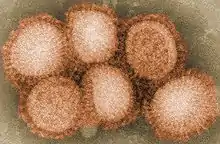Influenza A virus subtype H7N7
Influenza A virus subtype H7N7 (A/H7N7) is a subtype of Influenza A virus, a genus of Orthomyxovirus, the viruses responsible for influenza. Highly pathogenic strains (HPAI) and low pathogenic strains (LPAI) exist. H7N7 can infect humans, birds, pigs, seals, and horses in the wild; and has infected mice in laboratory studies. This unusual zoonotic potential represents a pandemic threat.
| Influenza A virus subtype H7N7 | |
|---|---|
| Virus classification | |
| (unranked): | Virus |
| Realm: | Riboviria |
| Kingdom: | Orthornavirae |
| Phylum: | Negarnaviricota |
| Class: | Insthoviricetes |
| Order: | Articulavirales |
| Family: | Orthomyxoviridae |
| Genus: | Alphainfluenzavirus |
| Species: | |
| Serotype: | Influenza A virus subtype H7N7 |
| Influenza (flu) |
|---|
 |
In 2003, 89 people in the Netherlands were confirmed to have been infected by H7N7 following an outbreak in poultry on approximately 255 farms. One death was recorded - a veterinarian who had been testing chickens for the virus - and all infected flocks were culled. Most affected people had mild symptoms including conjunctivitis.[1][2] Antibodies were found in over half of 500 people tested according to the final official report by the Dutch government:
As at least 50% of the people exposed to infected poultry had H7 antibodies detectable with the modified assay, it was estimated that avian influenza A/H7N7 virus infection occurred in at least 1000, and perhaps as many as 2000 people. The seroprevalence of H7 antibodies in people without contact with infected poultry, but with close household contact to an infected poultry worker, was 59%. This suggests that the population at risk for avian influenza was not limited to those with direct contact to infected poultry, and that person to person transmission may have occurred on a large scale.[3] Final analysis of Dutch avian influenza outbreaks reveals much higher levels of transmission to humans than previously thought.[4]
In August 2006, low pathogenic (LP) H7N7 was found during routine testing at a poultry farm in Voorthuizen in the central Netherlands. As a precautionary measure, 25,000 chickens were culled from Voorthuizen and surrounding farms.[5]
In June 2008, high pathogenic (HP) H7N7 was confirmed on a 25,000-bird laying unit at Shenington, England; probably derived from a pre-existing low pathogenic variety. Farmers Guardian reported a 2.5 per cent increased mortality in one shed and a reduction in egg production recorded two weeks before numerous deaths on 2 June that led to the diagnosis of HP H7N7 on 4 June.[6]
In October 2009, high pathogenic (HP) H7N7 was confirmed on a farm in Almoguera, Guadalajara, Spain. Hong Kong announced that it would suspend the import of poultry from Spain.[7]
In August 2013, high pathogenic (HP) H7N7 was found in markets in Wenzhou, Zhejiang province in China when testing for H7N9.[8]
In July 2015, high pathogenic (HP) H7N7 was confirmed on a poultry farm in Lancashire, England.[9]
In August 2020, H7N7 was confirmed on a free range farm in Lethbridge, Victoria.[10]
References
- "Early bird flu warning for Dutch". Panorama. BBC News. 6 November 2005. Retrieved 25 May 2015.
- "CDC - NIOSH Publications and Products - Protecting Poultry Workers from Avian Influenza (Bird Flu) (2008-128)". www.cdc.gov. 2008. doi:10.26616/NIOSHPUB2008128. Retrieved 30 July 2015.
- Bosman A, Mulder YM, de Leeuw JR, Meijer A, Du Ry van Beest Holle M, Kamst RA, van der Velden PG, Conyn-van Spaendonck MA, Koopmans MP, Ruijten MW (20 December 2004). "Avian Flu Epidemic 2003: Public health consequences. Executive summary". Rijksinstituut voor Volksgezondheid en Milieu. REFID 630940004. Retrieved 25 May 2015.
- Bosman A, Meijer A, Koopmans M (6 January 2005). "Final analysis of Netherlands avian influenza outbreaks reveals much higher levels of transmission to humans than previously thought". Eurosurveillance. 10 (12): 2616. Retrieved 25 May 2015.
- "Mild form of H7N7 bird flu found in Netherlands". Xinhua News Agency. 10 August 2006. Archived from the original on 4 March 2016. Retrieved 25 May 2015.
- "Poultry farmers' avian flu warning". Farmers Guardian. 20 June 2008. Archived from the original on 2 October 2009. Retrieved 25 May 2015.
- Sahuquillo, María R. (15 October 2009). "El virus de gripe aviar de Guadalajara es el H7N7". El País (in Spanish). Madrid. EFE. Retrieved 25 May 2015.
- Sample, Ian (21 August 2013). "New H7N7 bird flu strain discovered that could pose threat to humans". The Guardian. London. Retrieved 25 May 2015.
- Press Association (13 July 2015). "Bird flu confirmed on Lancashire farm". The Guardian. London. Retrieved 13 July 2015.
- "Bird flu case found on Victorian farm". NewsComAu. 2 August 2020.
Further reading
- Du Ry van Beest Holle M, Meijer A, Koopmans M, de Jager CM (1 December 2005). "Outbreak report: Human-to-human transmission of avian influenza A/H7N7, The Netherlands, 2003". Eurosurveillance. 10 (12): 584.
- "2. How the Virus Spread from Poultry to People and Pigs". Highly Pathogenic Avian Influenza Virus HPAI H7N7 - 2003 Epidemic in Europe. Pig Disease Information Centre U.K. 2010. Retrieved 25 May 2015.
- Suarez, David; Schultz Cherry, Stacey; Perdue, Michael; Swayne, David (23 September 2000). Comparison of Four H7n7 Avian Influenza Viruses Associated with Infection and Disease in Humans. Options for the Control of Influenza Conference. Agricultural Research Service, USDA. Publication #111993. Retrieved 25 May 2015. Abstract only.
- "Avian influenza in the Netherlands". Global Alert and Response, World Health Organization. 24 April 2003. Archived from the original on 30 April 2003. Retrieved 25 May 2015.
- Fouchier RA, Schneeberger PM, Rozendaal FW, et al. (February 2004). "Avian influenza A virus (H7N7) associated with human conjunctivitis and a fatal case of acute respiratory distress syndrome". Proceedings of the National Academy of Sciences of the United States of America. 101 (5): 1356–61. Bibcode:2004PNAS..101.1356F. doi:10.1073/pnas.0308352100. PMC 337057. PMID 14745020.
External links
- Influenza Research Database—Database of influenza genomic sequences and related information